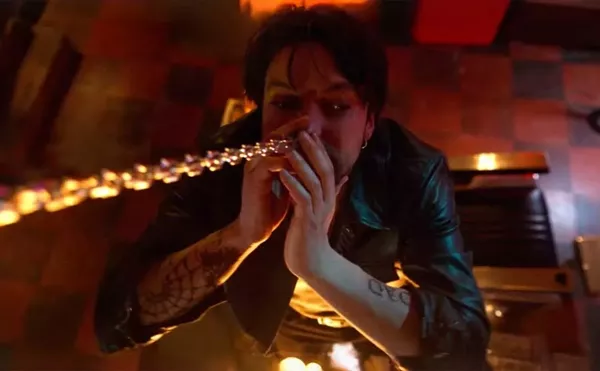
Audio By Carbonatix
[
{
"name": "GPT - Leaderboard - Inline - Content",
"component": "35519556",
"insertPoint": "5th",
"startingPoint": "3",
"requiredCountToDisplay": "3",
"maxInsertions": 100,
"adList": [
{
"adPreset": "LeaderboardInline"
}
]
}
]
The natural world and man-made world intersect to both beautiful and horrific effect in a new exhibit at Marygrove College. The show features installations by New York’s Judy Hoffman and Royal Oak’s Michael McGillis that employ found objects as entry points to the imagination.
Hoffman’s “Fertile Ground” features a series of small organic sculptures that hang from the walls like dozens of strange, delicately wrought creatures teeming in an alternate realm of existence. Hoffman grew up near the woods and recalls discovering nature as a child. “Playing with my brother in the woods, I’d construct homes among the trees with string, twigs, bark — anything we could find. There I found the beginnings of my gut impulses … and the origins of ‘Fertile Ground.’”
The result is a metamorphosis in which ordinary objects from the natural world are combined with everyday man-made objects to become something never seen before; in fact, Hoffman sees them as “new species” of life. So fine threads of gleaming copper wire, coiled strips of birch bark, pieces of colorful hand-made paper are arranged into organic forms. There are suggestions of spindly, jellyfish-like tentacles, seedpods, flower stamens, bladders, birds’ wings and exotic insects. These objects appear caught in midmovement as they float, fly, dance or wriggle through their unique microcosms.
Hoffman’s pieces are complemented by a series of drawings that hang in the adjacent, main room where McGillis has installed his sculptures. The drawings are quickly sketched renderings of organic objects — the same recurring configurations resembling pods, flowers, seeds and other natural elements that appear in her sculptures.
These drawings served as blueprints for the sculpted pieces. During an outing in the country, she began what she calls “automatic drawing”— sketching freely without imposing any mental dictates on the process, allowing elements to emerge from the subconscious. What appeared on the paper surprised and excited her. “There’s a life energy there. … I feel as if I hear sounds, vibrations of some kind.” These imaginative renderings inspired Hoffman, who had been primarily working in two dimensions before, to go 3-D, piecing together various objects to create new “living” forms.
Whereas Hoffman works her creative transformation with playful, impulsive life energy, McGillis illustrates a darker realm. He has created a series of scale cross sections of places and situations where humankind has introduced an alien element. The pieces, minutely constructed reproductions, invite the viewer deep into the landscape of each work.
One sculpture, meant to depict an oil-drilling scene from South America, features a pedestal of folded and stacked old work clothes, brown in color, suggesting layers of geological strata. At the surface is a body of water populated with tiny oil rigs, each drilling deep into the earth. Far below the ground on one side of the pedestal is a small hollowed cave filled with poison dart frogs.
Another piece considers the case of gypsy moth defoliation that plagued Virginia forestland in recent years. McGillis has incorporated a piece of fleece to replicate the way this species — introduced by man — stripped the landscape. Another cross section depicts people fishing with explosives, a problem in Southeast Asia.
McGillis also included two small steel sculptures in the show, both inspired by pine tree plantations in Northern Michigan. The pieces, colorful red-and-blue industrial-looking metal structures, contain thousands of long pine needles that resemble the trunks of trees (which are actually harvested from the plantations).
In creating these scale pieces, McGillis chose to work with found materials instead of more conventional mediums. “I didn’t want them to be made out of natural materials and be limited by that. So I just started buying things that reminded me of natural materials but that weren’t necessarily natural. … Rather than [making] fake landscapes out of the usual materials, I wanted to work with whatever’s already there.”
One type of found object in particular plays a recurring role in the work: old mattress fabric and pieces. The fabric not only works to replicate the landscapes but also carries conceptual meaning regarding issues of passivity and environmental crisis. “These mattresses were the starting point for all of them because I wanted [the scenes] to take place on a surface that’s really passive. When people are sleeping, they’re not doing anything … there are other things taking place somewhere else at the same time.”
Works by Judy Hoffman and Michael McGillis are on display through Oct. 24 in the Gallery at Marygrove College, 8425 W. McNichols, Detroit. The gallery is open Monday-Thursday, 9 a.m.-5 p.m. Friday and Saturday showings are by arrangement. For information, call 313-927-1370.
Christina Kallery writes about art for Metro Times. E-mail letters@metrotimes.com




